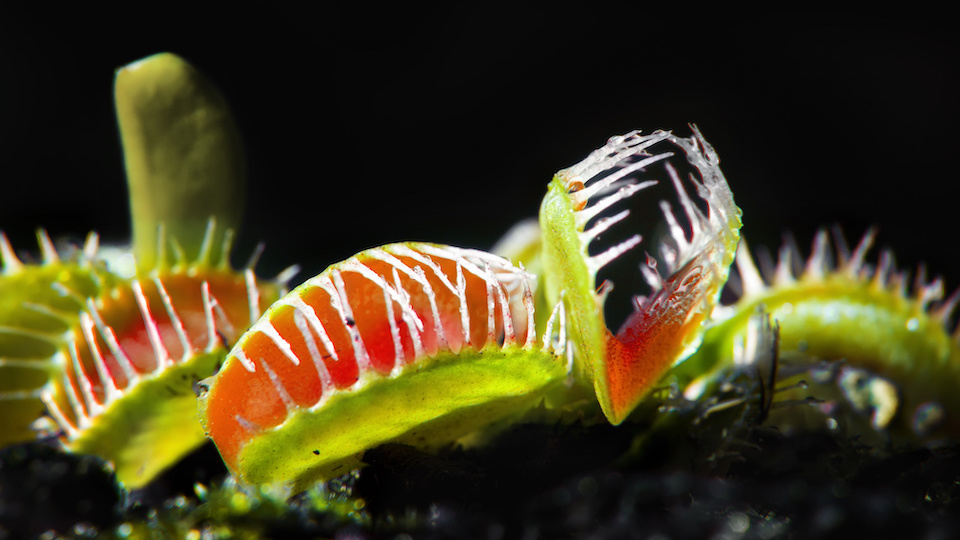Carnivorous and plant aren’t exactly two words that go together, and you probably don’t often think of plants that “eat” bugs. However, this category of intriguing flora is incredibly fascinating and deserves a lot more attention than it gets. If you’ve always wanted to try growing a plant that catches its own food but didn’t know where to start, you’ve found what you’re looking for. These three carnivorous plants are great for beginners and are incredibly easy to grow if you follow a few simple guidelines.
Pitcher plant
Perhaps the most menacing of all of the carnivorous plants, the pitcher plants beauty is directly at odds with it’s gaping maw just waiting to capture another unfortunate insect. It is called a pitcher plant for a reason since the plant is primarily made up of long, tubular leaves shaped like a pitcher at the end. They come in lovely colors ranging from pink, purple, and yellow shades; however, the Sarracenia purpurea or purple pitcher plant is the best one to grow indoors. Remember, these plants are incredibly light hungry, so it is vital to keep it in an area with direct sunlight. If you don’t have a bright window, or if all of your windowsill realty is taken over by other plants, invest in a grow light to keep it healthy.
Venus flytrap
Even if you’re a total carnivorous plant amateur, you’ve undoubtedly heard of the famous venus flytrap. Little mouths wait open, emitting the scent of sweet nectar to help lure unsuspecting bugs into its fatal trap. Once the bugs make contact with the leaves, trigger hairs send an electrical pulse that snaps the “jaws” closed, trapping the insect inside. The plant closes up, and digestive enzymes complete the process. About a week later, the traps will open, and the cycle will begin again.
Sundews
Sundews have an incredibly exciting visual appeal, with long, thin tendrils covered in a sticky, insect-trapping substance. There are tons of varieties, but most have brightly colored filaments such as orange and red that help lure in their prey. Once an insect is caught in the sticky trap, the arm will fold in on itself and until the bug is thoroughly digested.
Tips for growing carnivorous plants
Don’t fertilize
Unlike other plants, carnivorous foliage gets all of its nutrients from the insects it traps. These digested bugs provide plenty of nitrogen, potassium, phosphorus, and other plant nutrients, which is why these plants are often found in nutrient-poor soil. Simply put, they don’t need it and can thrive where other plants would starve. Keep fertilizer away from your carnivorous plants. It can burn the roots and is totally unnecessary.
Use low-mineral water
Though it can be a hassle to water your carnivorous friends with different water than the rest of your houseplants, regular tap water often contains too many minerals and salt that could cause wilting and browning. Instead, collect rainwater from your gutters, or use distilled water. Since most carnivorous plants hate to dry out, rest the pot in a tray of this low-mineral water or give it a drink daily. Not all carnivorous plants require as much water, however, so be sure to take note of individual water needs.
Remember feeding
Though fertilizer is a no-no, you may still have to supplement your plant with some extra insects. Since it is indoors, where there are hopefully no bugs, buy some bloodworms (usually sold as fish food) from your local pet store. Give your plant about one bug a week to keep it well-fed and happy.
Let them go dormant
Most carnivorous plants, except those of the tropical variety, need a period of dormancy to prepare for the following year. At the end of November, move your plants to a colder area out of bright, direct light to help it rest up for a spring of vibrant growth. Move them back into the warmth around February.
Soil needs
Never grow your carnivorous plant in regular potting soil! It is far too heavy and full of extra nutrients that could kill your plant. Instead, grow it in poor soil that can be peat moss, perlite, sand, or a mix of all three.
Have you ever grown a carnivorous plant? How did it go? Let us know in the comments below!
-Taylor Ramsey



